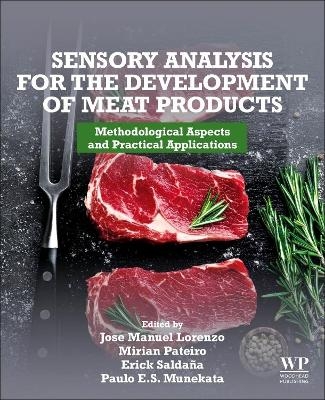
Sensory Analysis for the Development of Meat Products
Woodhead Publishing (Verlag)
978-0-12-822832-6 (ISBN)
José Manuel Lorenzo is Head of Research at the Meat Technology Centre of Galicia (CTC), Ourense, Spain and Associate Professor at the University of Vigo, Spain. He received his M.S. in Food Science and Technology (University of Vigo). He obtained his Ph.D. in Food Science and Technology (University of Vigo) in 2006. He has started his scientific career in the Department of Food Science and Technology at the University of Vigo, first as researcher scholarship, then, since April 2006, as academic Researcher. In 2006-2005 from October to March, he completed a stage period for his research project at the Stazione Sperimentale per L´Industria delle Conserve Alimentaria, (Parma, Italy). He has been PI of several projects of R&D and innovation related to meat science and food technology. He has developed numerous projects, many related to agro-industry and meat companies, and acquired extensive experience in the field of food technology. During this period, he completed my analytic training in LC and GC, developing methods to quantify levels of lipid/protein oxidation, lipid fractionation by SPE and vitamins with HPLC/FD/DAD and volatiles by GC/MS. These have focused on 1) Characterization of the products from different species under different rearing conditions, such as pigs, poultry or horsemeat; 2) Extension of food shelf life using natural extracts with antioxidant and antimicrobial capacities from agro-products; 3) Understanding physicochemical, biochemical and microbial changes during the technological processes applied to meat products; and 4) Development of new, healthier meat foods based on fat and salt reduction or improving lipid profile modification, replacement of fat, or incorporating functional compounds. Currently, he is involved in identifying proteomic and biomarkers associated with pastiness in dry-cured ham and their consequences for meat quality, using proteomic 2-DE techniques for protein separation and subsequent identification and quantification applying HPLC/MS/MS. Mirian Pateiro Moure is a researcher at the Centro Tecnológico de la Carne de Galicia, Ourense, Spain. Her scientific production includes 164 scientific articles in high impact peer-reviewed journals and 25 book chapters in the food science and biochemistry areas, as well as 89 scientific communications to national and international meetings, congresses, and symposia. Erick Saldaña is Research Professor at Universidad Nacional de Moquegua (Moquegua - Perú) and obtained his PhD student in Food Science and Technology in the Luiz de Queiroz College of Agriculture of the University of São Paulo (Brazil) in 2019. He obtained his Bachelor degree in Agroindustry Engineering in the National University of Trujillo (2010) and his Master degree in Food Science and Technology (2015) in the Luiz de Queiroz College of Agriculture of the University of São Paulo. He has been carrying out studies on the development of new food products, social media, sensory analysis, and consumer science in processed food, mainly in meat products. He is the author of 48 scientific articles in well-recognized peer-reviewed international journals, 8 communications to national and international congresses. Paulo Eduardo Sichetti Munekata is a postdoctoral researcher (Juan de la Cierva – formación scholarship) at the Meat Technology Centre of Galicia (CTC), Ourense, Spain. He is the author of 129 scientific articles in well-recognized peer-reviewed international journals, 27 book chapters in international publishers, 40 communications to national and international congresses. Currently, he is directly involved in projects aiming to: 1) Characterize natural compounds with antioxidant activity; 2) Develop healthier food products (particularly meat products) using natural compounds (specially antioxidants); 3) Study the effect of natural and active ingredients in the technological properties of food products.
1. Introduction
Section 1: Methodological aspects of sensory analysis of meat products 2. Necessary considerations for sensory evaluation of meat products 3. Descriptive sensory analysis as an analytical tool for the sensory characterization of meat products 4. Alternative descriptive methods answered by consumers for the sensory characterization of meat products 5. Dynamic descriptive methods for sensory characterization of meat products 6. Statistical methods for the analysis of sensory data of meat products
Section 2: Practical applications of sensory analysis for development of meat products 7. Descriptive sensory analysis of meat - the baseline for any sensory innovation for meat products 8. Consumer sensory perception of dried cured meat products using holistic methods 9. Using the Rate-all-that-apply (RATA) methodology to include the consumers voice in the production of burgers 10. Consumer opinion about ham - the sensory challenge continues: Case study 11. Flash profile in the characterization of dry-cured meat sausages: Case study 12. Projective mapping in the development of frankfurter: Case study 13. Free choice profile method to optimize the development of sausages: Case study 14. Temporal Dominance of Sensation (TDS) as a tool for the development of smoked bacon: Case study 15. Dynamic profile to optimize the addition of preservatives in dry-cured sausages: case study
| Erscheinungsdatum | 18.01.2022 |
|---|---|
| Sprache | englisch |
| Maße | 191 x 235 mm |
| Gewicht | 570 g |
| Themenwelt | Technik ► Lebensmitteltechnologie |
| ISBN-10 | 0-12-822832-6 / 0128228326 |
| ISBN-13 | 978-0-12-822832-6 / 9780128228326 |
| Zustand | Neuware |
| Haben Sie eine Frage zum Produkt? |
aus dem Bereich


